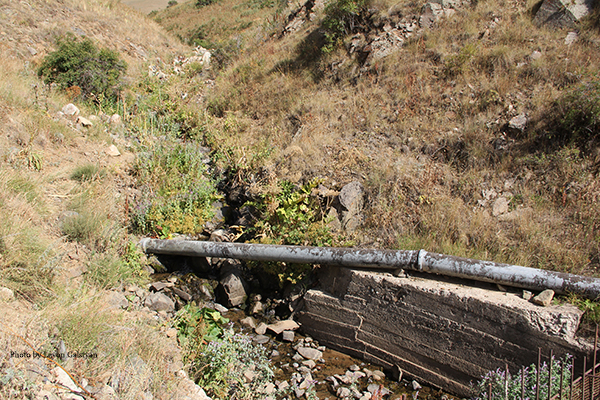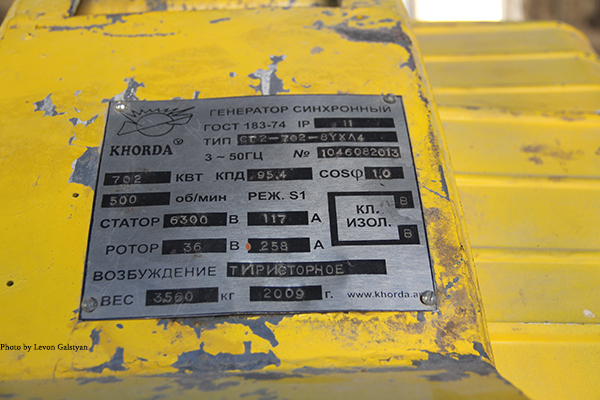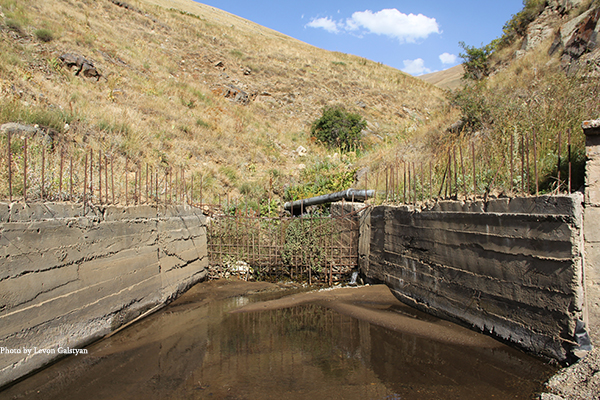

EcoLur
In the framework of the project entitled “Support to SHPP-relating Reforms Through the Dialogue of Public and RA Nature Protection Ministry for Sustainable Use of River Ecosystems” the expert group visited “Dastakert” SHPP. “Dastakert” SHPP is located in the administrative area of Dastakert community, Syunik Region. According to the water usage permit, the SHPP is constructed on the Ayri River, a tributary to the Vorotan (length – 25.5 km). As a result of the monitoring it turned out it’s constructed on the Kshkosht River (length – 10 km). It’s operated by “BASA SHIN” LLC.
As a result of the monitoring, the expert group found out:
- The SHPP has been operating since 2014.
- According to the project, the static pressure of the SHPP is 234.0 m, estimated pressure –205.8 m. The estimated yield used by the SHPP is 0.90 m3/s, projected capacity – 1404 kW, according to the certificate issued by the Public Services Regulatory Committee on 1 January 2015, the factual useful delivery of the electricity is 6.56 million kWh, according to the project, the estimated production is 6․56 million kWh (average), duration of license - 5.6.2014-3.6.2030, water usage permit -06.03.2013-06. 07.2013. At the moment of observation the SHPP didn’t have water usage permit.
- Since April 2015 the SHPP hasn’t operated because of lack of water, though according to the water usage permit, it can operate for 12 months and can use 15.2 million/cum water ensuring 0.08 cum/s environmental flow in the river.
- At the moment of observation (August) the water in the river was about 50 l/s, but the water usage permit says that the SHPP can use 590 l/s water in August.
- According to “Computation Center” CJSC data, in 2014 “Dastakert” SHPP operated for 5months in 2014 and produced 394357 kW electricity.
- The SHPP implements the water intake from the joining point of two rivers (one of the rivers flows through the tunnel, which was constructed to pass by Dastakert mine).
- The SHPP dam is two-sided – 7 and 6 meter long and 1.6 meter high.
- The fish passway is missing: the environmental flow is let out through the pipe incorporated into the dam.The absence of the fish passway in the head section constructed 2217 meters above sea level and the dam constructed on the riverbed ban spread of the brown trout, which inhabits in the small rivers of Armenia locates 2300 meters above sea level and over.
- There is no fish-protecting net in the head section, but there is garbage collector.
- Automatic management and registration of water intake and environmental flow is not ensured.
- The derivation pipeline is made of steel: its length is 1920 meters, diameter – 720 mm, which complies with the project solutions. It runs through a non-operating aqueduct. It’s not buries in the observed sections.
- Percentage correlation of aggregate length of SHPP derivation of “Dastakert” (1920 meters) with the length of Kshkosht River makes up 19. 2 % meters. At the moment of observation a new pipeline was being constructed to carry out water intake for “Ayri” SHPP (constructed on the Ayri River) from Kshkosht River.
- There are two turbines installed in the station of local production – “Khorda” LLC instead of projected three ones. At the moment of observation the turbines were not operating.
- The transformer substation is fenced and 1 transformer is installed.
- The station area is fenced and not greened, though the project envisages greening (tree planting) and improvement works in the station area.
- There is no water-meter sealed by a relevant environmental body in the water intake.
- There was no solution for the discharge of the household wastewater.
Conclusion
In fact, “Dastakert” SHPP has been constructed based on the hydrological data of the Ayri River, but it was constructed completely on another river with less water amount. Numerous technical and economic, project and hydrological data of “Dastakert” SHPP don’t comply with the reality, and because of them the business now faces problems: in 2014 it produced only 394,000 kW/h electricity instead of expected 6.56 million kW/h.
Proposals
- To specify the set in the water usage permit.
- To reconstruct the water intake section and to carry out the water intake through other hydrotechnical solutions instead of dam and to construct a fish passway, which will ensure free-of-obstacle movement of the fish.
- To install a fish-protecting net.
- To ensure automatic management of environmental flow, installation of water-measuring devices and online control.
- To re-equip the station and to install a turbine with high efficiency.
- To ensure entirely automatic management.
- To improve green and plant trees in the station area.
- To ensure a solution for the discharge of the household wastewater.
 |
|
 |
|
 |
|
 |
|
 |
|
 |
|
 |
|
 |
|
 |
|
 |
The material was developed in the frames of “Supporting reforms in the sector of small hydro power plants through enabling a dialogue between civil society and the Ministry of Nature Protection for sustainable use of river ecosystems” supported by UNDP/GEF Small Grants Programme".
February 16, 2016 at 17:55

